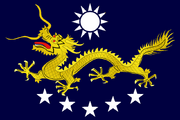
Indrala's national flag under the rule of the He dynasty
The History of Indrala is long and complex. Disagreements between experts are common and the regular emergence of new evidence means that the consensus view is regularly changing and being updated.
In general, the history of Indrala can be split into four eras: the pre-historic era, the ancient era, the colonial era and the modern era. Written records about the modern era are common and for this reason, information about this period is far more plentiful and considerably less disputed.
Prehistory
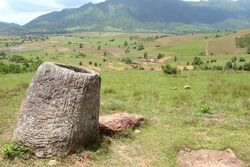
The Danging burial site in northern Jiaozhi provides the earliest evidence of human life in Indrala
Biologically-modern humans are believed to have arrived on the island of Indrala around between 30,000 and 10,000 BCE, arriving from continental Dovani (via present-day Dalibor) using primitive sea-faring technology. Exact dating of the crossing is hotly contested. Some experts argue that it happened pre-25,000 BCE and that it indicates the first usage of boats by humans to cross a body of water but the general consensus is close to 18,000 BCE.
For several thousand years, these populations lived as hunter-gatherer tribes, primarily in the north-eastern regions of Indrala which today comprise the Jiaozhi province. It was during this period of isolation that the Indralan people became distinct from the other Gao-Showa people groups who continued to inhabit mainland Dovani.
Ancient history
The period of Indralan history prior to the colonisation of the island by Aloria is often called the ancient period and includes the establishment of the first Indralan cities and the rise and fall of various kingdoms and empires.
Early kingdoms (2600 BCE-113 CE)
Mengmai is regarded as the first permanent settlement in Indralan history. Founded around 2,600 BCE, little is known about the civilisation due to a lack of evidence. No written records exist however a scientific excavation in the 33rd century revealed signs of pottery and buildings at Mengmai.
Later, Mengmai would form the heart of the Kingdom of Mesing. For several hundred years the various Kings of Mesing controlled almost the entire population of Indrala at the time. In 560 BCE, however, the kingdom was overthrown by a combination of invasion and crisis within the ruling families.

Reproduced versions of early characters found engraved on Gemu-Teng era pottery
After the downfall of Mesing, the Kingdom of Gemu-Teng was established in 560 BCE by the invading people, who came from north of Mengmai. It was during this period that written language first developed in Indrala. Indralan Syllabary (Indralan: Yingdala Tizi) was a system which used a single symbol for each syllable and was used exclusively until the 19th century when the Selucian alphabet became dominant due to western influence.
Gemu-Teng rule was brought to an abrupt end in 113 CE. Mount Shomi, a volcano located on the outskirts of Mengmai, erupted in the spring of that year and caused the near-destruction of the city. Known in the centuries after as 'the great burning', it led to the fragmentation of the Gemu-Teng kingdom in Indrala and was responsible for the loss of much written evidence of early Indralan civilisation.
It has been suggested that the Gemu-Teng established small settlements in the modern-day Kalistani districts of Suldanor and Ananto, which remained active despite the fall of the Indralan Gemu-Teng. Nonetheless, later colonisation but other Seleyan civilisations has caused the loss of most evidence which would support this theory.
Qin period (113-643 CE)
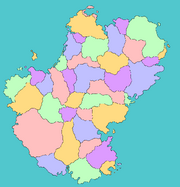
Indrala in 162 CE, when the island was at its most divided
Following the dissolution of the Kingdom of Gemu-Teng, the Qin period, also known as the Indralan Dark Ages outside the country, began. Numerous warlords took control of the remaining sections of the Gemu-Teng kingdom and began to compete to amass land and citizens.
During this time, the as yet unsettled southern parts of the island were properly colonised. Until then, the region was home to only hunter-gatherer tribes but the conquest of the competing warlords and petty nobles pushed them into these areas. In particular, the Ma-Gan River Delta became the centre of civilisation on the island due to its ideal farming conditions.
In 330, the leader Venshi united nearly all of the competing factions and established a military government. Through a mixture of diplomacy, conquest and innovative systems of promotion, the regime remained in control for around three hundred years. In spite of this, it was never able to rule the entire island and was constantly under threat from smaller states and barbarian tribes.
Talmu period (643-950 CE)
Eventually in 643, the Qin government collapsed and the various regions evolved into city-states, triggering the Talmu period.
Great Xinhan Empire (950-1153 CE)
In the year 950, a charismatic peasant leader, Liu Ji overthrew the feudal lord of the territory in which he lived, with the support of bandits from outside the region. Declaring the previous ruler an unjust tyrant, Liu proclaimed himself king and named it Xinhan. Over the following years, Liu Ji led his armies across the island conquering and uniting the various civilisations (city-states, fiefdoms, kingdoms etc).
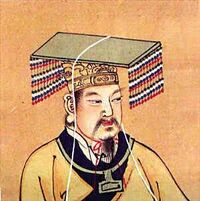
Liu Ji, the first ruler to unify Indrala
Upon their consolidation as a single empire, Liu Ji became the first leader to rule over the entire island of modern Indrala. Opinion is split on how he achieved this remarkable feat but Liu is known to have utilised primitive guerrilla warfare and recruited mercenary bandits to strengthen his armies. Many suggest he concluded specific agreements with these groups to achieve strategic cooperation.
Liu Ji's empire was known as the Great Xinhan Empire (Indralan: Da Xinhan Guo) and was ruled by the Imperial Liu clan for two centuries. During this period, many features associated with Indrala and its imperial governance were first developed. Notably, the ruler was known by as an Emperor or, more literally, 'August Sage-King' (Indralan: 皇帝 or Huángdì) and as the "Son of Heaven, and Lord of Ten Thousand Years and of the Present Time", a tradition which continued, intermittently, until the 42nd century.
Under the rule of Emperor Liu Che, the Xinhan reached its zenith. The Imperial Army was significantly strengthened and developed pioneering equipment and strategy. In addition, the empire began trading with other states across Terra, where a demand for Indralan goods developed, especially across the Schismatic Sea in Aldegar and Canrille.
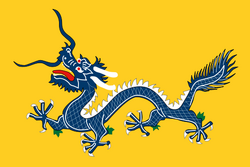
Flag of the Great Xinhan Empire
During the Xinhan period, strong relations with the Empire of Gao-Soto were developed. This meant the spread of Gao-Soto culture, particularly literature, to the island. Furthermore, Jienism spread to Indrala for the first time and began to integrate with, and in some cases replace, Indralan folk beliefs. Classical Gao-Showa also began to influence the native Indralan language of the time.
Eventually the empire became weak, however. Poor political decision-making and corruption from the imperial nobility caused the empire to crumble between 1151 and 1153. Afterwards, the remnants of empire became smaller territories and kingdoms with no unifying single government until reunification by Shuro Dureas and the United Indralan Commonwealth in 1213.
Zhen period (1153-1213 CE)
Following the fall of the empire but before the Commonwealth, the time was known as the Zhen period. During this time, there were a small number of powerful and expansive kingdoms on the island. The Zhen period was characterised by constant war between them.
United Commonwealth (1213-1450 CE)
Following a period in which various territories held fluctuating power, the Kingdom of Beizhou emerged as the most powerful led by Shuro Dureas. Born in a peasant village, he joined the King's army and rapidly rose through the ranks. Eventually, the king adopted Shuro as his son and heir.
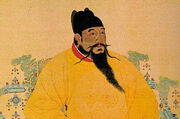
Shuro Dureas during his rule
Upon the king's death in 1210, Shuro began an ambitious campaign against Beizhou's neighbouring states. Utilising his vast armed forces, he was able to unite the rest of Indrala under his rule in 1213, aged just 20. Declaring himself "Paramount Leader" (Indralan: Zuìgāo lǐngdǎorén), he created the United Indralan Commonwealth (Indralan: 合众英大拉联邦王国 or Gezhong Yingdala Lianbang Wangguo).
Shuro split his new state between various nobles and commanders, granting them titles and authority in order to ensure the Commonwealth remained united. Underneath the paramount leader, the most powerful title was that of "Beiyi", regional commanders. One notable example was Deng Qihong of Clan Deng, the Beiyi of Akuzia.
When Shuro died in 1254, he left no heirs to his territory and provided no mechanism through which to determine one. In order to ensure the state survived, the Beiyis convened to decide the future of the Commonwealth. It was decided that all nobles, including the Beiyis, would be entitled to elect the paramount leader from among their ranks. Recently, this system has been described as an 'elective monarchy' however the lack of real hereditary noble family makes this characterisation somewhat inaccurate.

Deng Puqi, the first elected paramount leader
At their first meeting, called a 'free election', the 3rd Beiyi of Akuzia Deng Puqi was the first elected Paramount Leader of United Indralan Commonwealth. In the period that followed, nobles from Clan Tan of Quibashi, Clan Liang of Kathuran, Clan Li of Luratha, and Clan He of Mishari Karula would all hold the position.
Generally, the Commonwealth period was characterised not as a time of great economic prosperity but of significant cultural development nonetheless. Retrospectively, it has been called the Indralan Golden Age (Indralan: Gudian Gudai). Arts and literature experienced a surge in popularity, with dozens of Indrala's most famous classical pieces dated to the Commonwealth era.
Additionally, it was during this time the terms yingdalaren or simply yingren entered popular usage to describe native Indralan culture as well as yingdalayu for the spoken and written language. The native name for the island, yingdala was the source of these terms and remains the name for the country domestically although the westernised Indrala has overtaken in foreign countries.
Nevertheless, the Commonwealth collapsed in 1450 in the wake of an intense dispute over crop production. In the populous peasant south, rice was cultivated due to its cheap price and relative abundance. The ruling nobility, mainly based in the north, favoured growing corn instead as it was, in their view, better tasting and perceived as more prestigious. Switching to corn production was expensive and risky, though, and many southern nobles supported their citizen's decision. Consequently, the Commonwealth was split between the various Beiyis, each with their own allies and rivals.
Enzo period (1450-1794 CE)
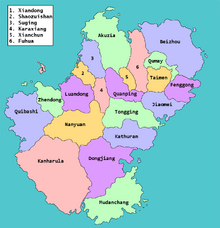
Political map of Indrala c.1689
In the Enzo period, the country was governed by the numerous Beiyis. While there were numerous conflicts between the various rulers and states, the island was generally at peace since many of the newly founded Beiyidoms (sometimes simply referred to as kingdoms) has cooperated with one another under the United Commonwealth. During the Enzo period, no ruler was able to maintain control of even half of the Indralan mainland.
Colonial rule
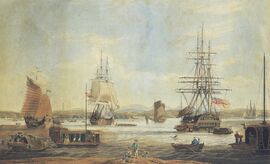
Alorian Eastern Trading Company ships arrive in Indrala, 1722
In 1718, William Prescott led a four-ship expedition of merchants from Aloria to Indrala in an attempt to expand the nation's influence in the region and combat the dominance of Seleyan nations on international trade.
Initially the expedition appeared to be a failure however a permanent trading post was established in Quibashi in 1722, the first signs of success for the Alorians. With the permission of Beiyi of Quibashi, further settlements were established along the Indralan west coast. Notably, the first factory was built by the settlers in 1728 in Hazhou.
In 1729, the government of Aloria granted the Alorian Eastern Trade Company (AETC) a complete monopoly over trade in the lands east of Seleya, particularly Indrala. The AETC, controlled by the government, was intended to co-ordinate and oversee Alorian interests in the region and was empowered to construct trading posts, conclude treaties and establish permanent settlements.
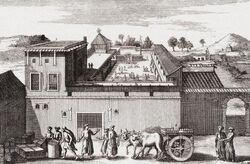
Drawing of an early Alorian trading post
In the following years, the AETC's operation expanded significantly and Indrala became a crucial destination in the flow of goods between Artania and Dovani, prompting other nations to attempt to establish similar arrangements with the leaders of Indrala's various states. Only Luthori was able to achieve any success, establishing a small number of trading posts on the south-eastern coast.
Between 1729 and 1750, over twenty factories were built along the Indralan west coast, most notably in Meihua, Shencheng and Longmen. Each was operated by a master merchant and a governor, with the latter representing the Alorian government's interests in the region. Initially, the local ruling nobles were enthusiastic about the development as a factory could provide as many as one hundred workers with a reasonable wage. During this period, Indrala was a fractured nation, lacking centralised government of any form.
AETC rule (1794-1820 CE)
Aloria achieved a major success in their endeavours to dominate eastern trade, especially spices, when they overpowered the Luthori in the Indralan Continental War. Richard Hayes, Governor-General of the AETC led Alorian forces to an overwhelming victory against the Luthorian occupants of the island and captured their settlements for the company. In doing do, any remaining threat to Alorian dominance on the island was eliminated.
As the company's importance to the local economy increased, the native rulers felt forced to grant Aloria further powers. Numerous accords, treaties and agreements were drawn up with Beiyis across the island, granting the AETC control over foreign affairs, trade and tax in exchange for protection from outside threats.

Deal with the West by Zi Zhong (1948) depicts John Penn meeting the Beiyi of Quibashi
In 1794, Governor-General of the Alorian Eastern Trade Company John Penn was instructed by King Peter II and Queen Isabella II to begin taking full control of Indrala. Penn met the Beiyi of Quibashi to discuss the AETC holding the rights to his region's land and resources in exchange for further Alorian protection. In spite of his deep reservations, the Beiyi needed the Alorians to prevent a rebellion against his rule thus he agreed to the terms.
Similar deals were negotiated with the Beiyis of Luandong, Kanharula and Zhendong between 1794 and 1797. Under the terms of these treaties, the Indralan rulers could not interact with each other or outside nations except through the Alorians. The AETC became the de facto ruler of the Beiyi's territory, with the actual leaders simply carrying out the decisions of the Alorian company. In 1798, the Beiyi of Akuzia became the final ruler to conclude a deal with the company and Indrala became entirely governed by Alorian rule.
Protectorate government (1820-1912 CE)
In 1819, the Beiyi of Luandong was assassinated by a pro-independence figure called Fang Tu who proclaimed the ruler's territory as 'free for all Indralans' and called on citizens to fight against the Alorian regime. The AETC sought to quickly quell the violence but the Beiyi's death had left them without anyone to support in the region (he had left no heirs) and the Indralan population had acted on Fang's words by sparking small clashes with the Alorian armed forces.
In an attempt to seize the momentum of the natives, the Beiyi of Nanyuan declared himself the 'Leader of the Free Indralans' and ordered his troops to seize both Nayuan and Luandong from Aloria. Before the situation became more difficult, the AETC mobilised their full force to restore order in the villages and towns of the two regions. The Beiyi of Nanyuan was executed and a reorganisation of the Indralan territory was ordered by the company's ]Governor-General.
Realised in 1820, the result was the Alorian Protectorate of Indrala. Under this system, the role of the AETC was significantly reduced and full institutions of central government were created. The Alorian monarch became the Emperor/Empress of Indrala and the Governor-General was their representative in the country. The Beiyis' role became advisory, with each 'province' being led by a governor.
Dominion government (1912-1933 CE)

Legislative Assembly building in Indrala
Under increasing pressure from the Beiyis and the local population, the Alorian colonial rulers instituted a number of reforms to the system of government beginning in 1912. A Legislative Assembly (Indralan: Lifa Hui) was created and the Governor-General was replaced by a Viceroy, whose role was almost entirely ceremonial. In addition, the state was re-titled the Alorian Dominion of Indrala.
Although the reforms gave significantly more power to the Indralan people, they were still viewed by many as inadequate and did little to ease the political pressure being placed on the Viceroy and the territorial governors. Throughout the Dominion period, several general strikes ground the Indralan economy to a halt and violence between the colonists and native people was not uncommon.
War of Independence (1933-1938 CE)
The Indralan War of Independence lasted five years and resulted in the establishment of a communist state under the chairmanship of the revolutionary leader Ruan Zhi, who gives his name to the political philosophy Ruanism.
Modern history
The period of Indralan history since independence from Alorian rule is referred to as modern Indralan history and runs until the present day.
People's Republic of Indrala (1938-2075 CE)
After winning independence for the Indralan people, Ruan Zhi established a communist state, known as the People's Republic of Indrala or Gongchan Indrala. Following his death, a number of other individuals ruled the country in its communist form. Although authoritarian, communist rule improved the lives of many Indralans who had been exploited by the colonial regime and there was little opposition for the first century of its existence.
United States of Indrala (2075-2549 CE)
In 2075, a liberal revolution, called the Minren Ziyou revolution, supported by the former nobles and conservative sections of the country overthrew the Communist regime and created the United States of Indrala (Indralan: Yingdala Gezhongguo), a loose federal government which was composed of both republican and monarchical states.
In 2404, the Workers' League of Indrala began the Indralan Insurrection, a rebellion against the Indralan state. Approximately 85,000 rebels and 53,000 government soldiers died in the conflict. The rebellion ended in March 2407 when the Workers' League collapsed and its militant arm surrendered. While general members and soldiers of the Workers' League of Indrala were granted amnesty, however, both its military and civilian leaders were tried, convicted on of war crimes and executed. Nevertheless, several key leaders of the Workers' League went underground following the failed insurrection. During this underground period, the Workers' League embraced Ahmadism and became known as the Populist Ahmadist Workers' League. The remaining leaders of the Workers' League were eventually granted amnesty, and in August 2416, Najwa Elzayed of the Populist Ahmadist Workers' League was elected President of Indrala with 43.6 million votes. Elzayed ruled until 2422, when another Workers' League President, Latifa bint Mohammad Aziz Abdallah, took office, ruling until 2441. In that year, the Workers' League announced the abolition of the office of president, which was in 2442 replaced by a Council for the Proletarian Dictatorship, which ruled until 2445. The year 2445 marked the decline of the Workers' League movement, as the Hosian Universalist Party took power, marking the beginning of a long period of right-wing domination. While the Indralan Insurrection of 2404-2407 was initially a failure, it foreshadowed in many ways the period of communist rule by the Workers' League from 2416 to 2445. President Elzayed would later call the insurrection a "dress rehearsal" for the peaceful takeover of Indrala by the Workers' League in 2416, inaugurating almost three decades of Workers' League rule.
Indralan colonialism (2549-2800 CE)
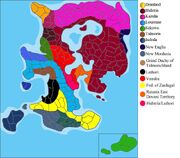
Map showing the annexed Indralan territory
In 2549, the Indralan legislature voted to annex the island of Dalibor, which was without a central government at the time. While the native people of Dalibor were related to native Indralans, centuries of separation had caused serious differences in culture, language and appearance to arise. Furthermore, the Indralan government drew up plans to annex sections of mainland Dovani (modern Kimlien), in response to outside colonists attempts to control the region.
Quasi-dictatorship (2800-2875 CE)
On 6th September 2800, a coup d'etat was launched against the Indralan government. Known as the Revolt of the Sergeants, it successfully removed President Thomas Eddie from power, decrying him as an Alorian colonist. In his place, Diosdado Hortal became the Indralan head of state by winning a questionable election in 2808.
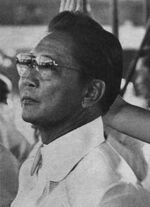
President Diosdado Hortal during his rule
Mixed evidence and unreliable sources make it extremely difficult to determine whether Diosdado's election was free and fair or not. While the circumstances would suggest otherwise, there are no conflicting accounts of the events, even outside of Indrala from that period of time. Regardless, Diosdado began a programme of economic reconstruction, agricultural reform and improved relations with Greater Hulstria.
Amidst a backdrop of increasing corruption, suppression of opposition and personality cult, elections in 2812 inflicted a massive defeat on Diosdado and victory for the Gekokujō, the first Zenshō Socialist party. Under their rule, the country was reorganised the Enlightened People's Republic of Indrala and the regime began an invasion of Hanzen.
Another coup took place in 2833 when the Nationalista Party seized power led by Bumipol Ran Pan. Like his predecessors, Bumipol was unable to consolidate his rule effectively. Although he succeeded in holding power for several years, he could not entirely eliminate the threat from either the radical left or the monarchist right.
Divided rule (2875-3074 CE)
Following several decades of increased democratic elements, the year 2875 saw the rise of the Kuomintang, who formed a government based on liberal democratic values and soft conservatism. While focusing on westernising Indrala's society and economy, the party was controlled by members of Clan Deng, which included the traditional Beiyi of Akuzia. Meanwhile, the monarchist movement in Indrala was regaining momentum. Supporters of the Diguodang called for the establishment of a new empire, with Liu Che as its Emperor.
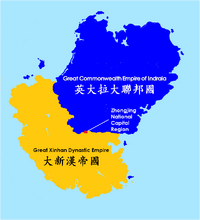
Division of Indrala in the 29th century
Indralan politics became extremely polarised, with the south favouring the crowning of the Emperor and the northern regions supporting the re-establishment of the United Commonwealth. In order to prevent a conflict, both sides reached an agreement whereby Indrala would be divided into the a commonwealth in the north and an empire in the south. However, this was to be a temporary arrangement until peaceful unification could be achieved and the ruling houses united.
By the beginning of the new millennium, the desired unification had not been realised. Disagreements between Clan Deng and Clan Liu, exacerbated by the re-emergence of the Zenshō socialist movement, prevented the creation of a single state. During the decade of the 30th century, political violence became increasingly prevent and the Indralan government was severely at risk.
Over the next hundred years, the relationship between the two regimes became hostile. Although neither involved themselves in military conflict, both began to claim sovereignty over the entire island though, in reality, it remained clearly divided. Agitation by Zenshō Socialists in south only heightened the tension.
Between 3031 and 3065, there were a number of rulings and decrees involved the ruling noble families. At one point, the marriage of Deng Xiaodao and Liu Baihe united the families into the Imperial House of Deng-Liu but the lack of children prevented the resolution of the divided island. Eventually, the Liu clan were able to secure the throne and the Great Empire of Indrala was established to succeed both states.
Great Empire of Indrala (3074-3355 CE)
For several decades, the Deng clan retained a senior role in the Indralan nobility, as ceremonial rulers of Anle. However by 3110, the Eunuchs Of The Crown had ordered their exile from the country and solidified the Clan Liu claim to the Dragon Throne. With the support of the Gao Clan, the Xinhan dynasty was rebuilt.
Despite initial instability during the Jiaozhi Revolt, the Empire began pursuing policies to stabilise Indralan governance and expand the country's political influence. Xinhan success was most evident in the development of a Jienist bureaucracy to serve the country and the demanding of the Great North Dovani Plain from Kazulia. For around half a century, between 3236 and 3300, the Ji clan took control of the Indralan throne, in the wake of the Great North Dovani Plain Crisis however Liu rule was restored under Liu Qin.
In 3337, the Tengyuan Clan, led by Tengyuan Xinyu took advantage of the emergence of the Blue Lotus Society and the subsequent Blue Lotus Rebellion to overthrow the ruling Liu clan and establish the the Mingzhi Dynasty. Under Mingzhi rule, the country was drawn into the Southern Hemisphere War, alternatively known as the Great Dovani War.
Jienist state (3355-4114 CE)
After the Southern Hemisphere War, members of the old bureacracy and scholars, believing the Mingzhi Dynasty was leading Yingdala down the path of constant warfare and high taxation, led a peaceful uprising against the government. Facing a potential rebellion, the Xin Emperor ordered an election, largely meant to be a referendum on his leadership. Unfortunately for him, the people traditionally associated with the old regime retook power, former the Jien-Democratic Party out of the ashes of the Imperial and Jien-Imperial Parties.
The Jien-Democrats immediately tried the Xin Emperor for treason and forced him out of power, leading to Tengyuan Xinyu's ultimate humiliation. Following the Xin Emperor's downfall, the Jien-Democrats ushered in a Jienist revival, reforming all laws to conform with Jienist philosophy. Not only did the Jienists turn Yingdala into a Jienist State, but they persecuted Zensho Daenists.
With the radicals in Yingdala eliminated, the Jienpai consolidated power and placed their preferred candidate from the House of He on the Dragon Throne in 4076. At first, the new monarchy led to a long period of stability and issued important laws secularizing institutions that had been brought under religious control under the previous dynasty.
Military Dictatorship (4114-4141)
Problems, however, began to emerge in 4114 when the Jienpai-led cabinet began systematically withdrawing Yingdala from all international treaties, accelerating the economic collapse of the country. It was at this point that the General Staff began to exert greater control over governance.
As order broke down, the military formally seized power in the coup d'état of 4127, nationalizing nearly all sectors of the economy and crushing dissent. By the mid-4130s, it was believed that organized opposition to the regime was impossible, given the disappearance of former opposition party figures and public intellectuals. However, organized efforts by the militant Labor Party and the moderate Social Democratic League gained momentum as the junta splintered into violent factional struggle.
Third Republic (4141-Present)
In February 4137, a meeting of labor, environmental, and feminist activists met in Tian'an to establish the Social Democratic League. The party contested -- and won -- election to the recently expanded Court Conference, and used their position to restore responsible government (beginning January 4138) and proclaim a new Republic of Yingdala (December 4141). The Social Democratic League shared power with two successive left-wing parties, and during the collapse of the second of these parties (the National Worker's Party) and simmering resentment within the SDL, a successor party was formed, named the Yingdalan Progressives (January 4157) under the leadership of Prime Minister Cindy Tang. In a flurry of activity, the new Government accomplished much, including the first international agreement in recent Yingdalan history, the Taixi Progressive Trade Accord (June 4157).
Footnotes

|
State of Indrala
瑩大磖國 (Indralan) | |
| History | Historic Events: Blue Lotus Rebellion - Dawei Miracle - Southern Hemisphere War - War of Independence - Yu Restoration Historic Periods: Mesing - Gemu-Teng - Qin - Talmu - Great Xinhan - United Commonwealth - Alorian Protectorate - Gongchang - Mingzhi - He - Yu - Wen Important Sites: Heavenly City - Mengmai - Temple of Ten Thousand Bidars | |
| Geography | Natural Features: Anle Range - Baitian Valley - Fehua Bay - Ma-Gan River - Tebie Desert - Shengo Rock Provinces: Han - Jiaozhi - Min - Anle - Shu | |
| Politics | Prime Minister of Yingdala - Legislative Council Political Parties: | |
| Demographics | Ethnic Groups: Indralan - Kyo-Indralans - Dinh - Bianjie - Kunihito Religion: Jienism - Guidao - Daenism (Mazdâyanâ, Zenshō) - Seodongyo | |
| Culture | Monarchy - Nobility - Sport | |
| Economy | Agriculture - Banking - Caizu - Industry - Jiaozhi Miracle - Mining - Tourism | |
